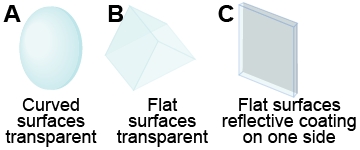|
Optical devices may change the path of light rays through reflection and refraction. Reflection bounces light off of a surface, such as a mirror. Specular reflection occurs with shiny surfaces and diffuse reflection occurs with nonshiny surfaces, such as paper. Refraction bends the path of light as the light passes from one medium into another, such as from glass into air and vice versa. Refraction is the principle behind prisms and lenses. Both reflection and refraction can be used to form images. Magnification occurs when an image has a different apparent size than an object. Dispersion occurs when an optical element separates white light into its constituent colors, such as a prism creating a rainbow. Optical media may have varying degrees of opacity, transparency, or translucency. 
|
|
mirror, lens, prism, reflection, refraction, specular reflection, diffuse reflection, magnification, transparent, opaque, translucent
|
|
|
|
Review problems and questions |
|

- Match each diagram (A, B, and C) to the appropriate name (i–iii) and function (a–c) from the list.
| Name | Function | - Mirror
- Lens
- Prism
| - Refracts light and may magnify.
- Reflects light and may show images.
- Refracts light without magnification.
| 

|
Diagram A is a (ii) lens that (a) refracts light and may magnify.
Diagram B is a (iii) prism that (c) refracts light without magnification.
Diagram C is a (i) mirror that (b) reflects light and may show images. 
|
- A ruler of length 30 cm is submerged in a tank of water. The image seen outside the tank is measured to be 36 cm long.
- What is the magnification of this system?
- In centimeters, how long would a meter stick in the tank of water appear to be?


|
Answer: - 1.2
- 120 cm
Solution: - Asked: magnification m from the tank
Given: length of ruler, ho = 30 cm; length of the image, hi = 36 cm
Relationships: m = hi ⁄ ho
Solve: Answer: The magnification of the tank is 1.2. - Asked: height hi of an image of a meter stick in the tank
Given: magnification of the tank, m = 1.2
Relationships: m = hi ⁄ ho, length of a meter stick ho = 1 m = 100 cm
Solve: Rearrange and solve for hi: Answer: A meter stick would appear to be 120 cm long. 
|
- A piece of sandpaper may turn a transparent plastic window into a translucent plastic window. Propose a hypothesis to explain why sanding the surface makes the window translucent. Use the concept of light rays in your explanation.


|
The direction light travels can be diverted by refraction. When the surface is roughened, light rays that are adjacent to each other are refracted in different directions when crossing the sanded surface. The light rays still mostly get through the window, so it does not become fully opaque. The diversion of adjacent light rays into random directions scrambles the image, making the window translucent. 
|
- How large does the image of a 10-m-tall tree appear when using an optical device with a magnification of 0.3?


|
A magnification of less than one corresponds to a reduction in the size that the image relative to the original object. The 10-m-tall tree will appear to be 0.3 × 10 m = 3 m tall. 
|
- In Investigation 20A on page 586, which optical device would you choose to
- create a magnified (enlarged) image?
- create an upside-down or inverted image?
- create an image the same size as the object?


|
- a convex lens and a concave mirror (in certain conditions)
- a convex lens and a concave mirror (in certain conditions)
- a flat mirror

|
- How should you handle a lens when you pick it up?

|
Hold it by its edge to avoid touching the optical surfaces. 
|
Take a Quiz |

